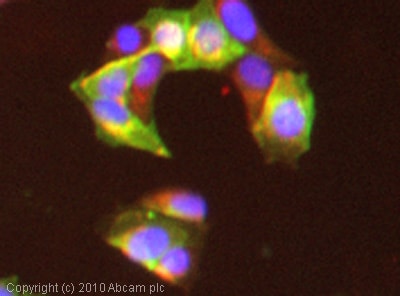Anti-MUC1 antibody (ab84597)
Key features and details
- Rabbit polyclonal to MUC1
- Suitable for: IHC-P, ICC/IF, WB
- Knockout validated
- Reacts with: Human
- Isotype: IgG
Overview
-
Product name
Anti-MUC1 antibody
See all MUC1 primary antibodies -
Description
Rabbit polyclonal to MUC1 -
Host species
Rabbit -
Tested Applications & Species
See all applications and species dataApplication Species ICC/IF HumanIHC-P HumanWB Human -
Immunogen
Synthetic peptide corresponding to Human MUC1 aa 1200 to the C-terminus conjugated to keyhole limpet haemocyanin.
(Peptide available asab94832) -
Positive control
- This antibody gave a positive signal in the following lysates: MCF7 Whole Cell; HeLa Whole Cell; Human Lung Tissue; T47D Whole Cell
Images
-
IHC image of MUC1 staining in Human Breast carcinoma FFPE section, performed on a BondTM system using the standard protocol F. The section was pre-treated using heat mediated antigen retrieval with sodium citrate buffer (pH6, epitope retrieval solution 1) for 20 mins. The section was then incubated with ab84597, 5µg/ml, for 15 mins at room temperature and detected using an HRP conjugated compact polymer system. DAB was used as the chromogen. The section was then counterstained with haematoxylin and mounted with DPX
-
All lanes : Anti-MUC1 antibody (ab84597) at 1 µg/ml
Lane 1 : Wild-type HeLa whole cell lysate
Lane 2 : MUC1 knockout HeLa whole cell lysate
Lane 3 : MCF7 whole cell lysate
Lysates/proteins at 20 µg per lane.
Predicted band size: 122 kDaLanes 1 - 3: Merged signal (red and green). Green - ab84597 observed at 24 kDa. Red - loading control, ab9484, observed at 37 kDa.
ab84597 was shown to recognize MUC1 in wild-type HeLa cells as signal was lost at the expected MW in MUC1 knockout cells. Additional cross-reactive bands were observed in the wild-type and knockout cells. Wild-type and MUC1 knockout samples were subjected to SDS-PAGE. Ab84597 and ab9484 (Mouse anti-GAPDH loading control) were incubated overnight at 4°C at 1 μg/ml and 1/20000 dilution respectively. Blots were developed with Goat anti-Rabbit IgG H&L (IRDye® 800CW) preabsorbed ab216773 and Goat anti-Mouse IgG H&L (IRDye® 680RD) preabsorbed ab216776 secondary antibodies at 1/20000 dilution for 1 hour at room temperature before imaging. -
ICC/IF image of ab84597 stained MCF7 cells. The cells were 4% PFA fixed (10 min) and then incubated in 1%BSA / 10% normal goat serum / 0.3M glycine in 0.1% PBS-Tween for 1h to permeabilise the cells and block non-specific protein-protein interactions. The cells were then incubated with the antibody (ab84597, 5µg/ml) overnight at +4°C. The secondary antibody (green) was Alexa Fluor® 488 goat anti-rabbit IgG (H+L) used at a 1/1000 dilution for 1h. Alexa Fluor® 594 WGA was used to label plasma membranes (red) at a 1/200 dilution for 1h. DAPI was used to stain the cell nuclei (blue) at a concentration of 1.43µM. This antibody also gave a positive result in 100% methanol fixed (5 min) MCF7 cells at 5µg/ml.
-
All lanes : Anti-MUC1 antibody (ab84597) at 1 µg/ml
Lane 1 : MCF7 (Human breast adenocarcinoma cell line) Whole Cell Lysate
Lane 2 : HeLa (Human epithelial carcinoma cell line) Whole Cell Lysate
Lane 3 : Lung (Human) Tissue Lysate
Lane 4 :T47D whole cell lysate (ab14899)
Lysates/proteins at 10 µg per lane.
Secondary
All lanes : Goat polyclonal to Rabbit IgG - H&L - Pre-Adsorbed (HRP) at 1/3000 dilution
Developed using the ECL technique.
Performed under reducing conditions.
Predicted band size: 122 kDa
Observed band size: 24,26 kDa why is the actual band size different from the predicted?
Exposure time: 2 minutes
We hypothesize that the 26 kDa band represents the cleaved form of MUC1. Abcam welcomes customer feedback and would appreciate any comments regarding this product and the data presented above.





















